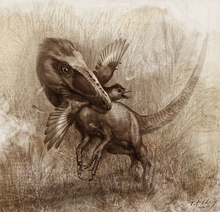Sinocalliopteryx
| Sinocalliopteryx | ||||||||||||
|---|---|---|---|---|---|---|---|---|---|---|---|---|

Sinocalliopteryx , live reconstruction |
||||||||||||
| Temporal occurrence | ||||||||||||
| Lower Cretaceous (early Aptium ) | ||||||||||||
| 126.3 to 123 million years | ||||||||||||
| Locations | ||||||||||||
| Systematics | ||||||||||||
|
||||||||||||
| Scientific name | ||||||||||||
| Sinocalliopteryx | ||||||||||||
| Ji et al., 2007 | ||||||||||||
| Art | ||||||||||||
|
||||||||||||
Sinocalliopteryx (English: wonderful Chinese feather ) was the largest genus of the theropod dinosaur family of the Compsognathidae . The only known species is Sinocalliopteryx gigas from the Chinese Yixian Formation in Liaoning Province , which is also the largest known feathered dinosaur from this formation.
description

The genus Sinocalliopteryx is known to us from a well-preserved specimen from the Chinese Yixian Formation deposits , more precisely the Jianshangou Basin, which is dated to the Lower Cretaceous (early Aptian ). This is approximately 2.50 m long and thus the largest fossil of a Compsognathid ever discovered. Sinocalliopteryx was completely feathered except for a few parts of the body, such as the ends of the extremities, and had short arms typical of Compsognathids , but unusually long hands with powerful claws. In addition, a leg fragment of a smaller dromaeosaurid theropod , now identified as Sinornithosaurus , was found in the stomach region of the holotype , which shows Sinocalliopteryx to be a hunter. Scientists found the remains of two specimens of the ancient bird Confuciusornis in the stomach region of a second Sinocalliopteryx fossil .
Way of life
The skeleton shows clear adaptations to an active predatory life. Like all Compsognathids, Sinocalliopteryx was a fast and agile runner, but in contrast to its relatives, it was also able to kill well-fortified prey of roughly the same size and thus distinguishes itself from Compsognathus or Juravenator , for example . Its habitat, the Yixian Formation , was covered with extensive forests in the Lower Cretaceous and housed various vertebrates .
Sinocalliopteryx is one of the largest known dinosaurs found there and is to be regarded as a top predator . In addition to him, other compsognathids were found, the comparatively large and closely related Huaxiagnathus and Sinosauropteryx , which were probably part of his prey spectrum.
literature
- John Long, Peter Schouten : Feathered Dinosaurs. The Origin of Birds. Oxford Univ. Press, Oxford et al. 2008, ISBN 978-0-19-537266-3 .
Individual evidence
- ^ Gregory S. Paul : The Princeton Field Guide To Dinosaurs. Princeton University Press, Princeton NJ 2010, ISBN 978-0-691-13720-9 , pp. 121-122, online .
- ↑ Lida Xing, Phil R. Bell, W. Scott Persons, Shuan Ji, Tetsuto Miyashita, Michael E. Burns, Qiang Ji, Philip J. Currie : Abdominal Contents from Two Large Early Cretaceous Compsognathids (Dinosauria: Theropoda) Demonstrate Feeding on Confuciusornithids and Dromaeosaurids. In: PLoS ONE . Vol. 7, No. 8, 2012, e44012, doi : 10.1371 / journal.pone.0044012 .
Web links
- Photo of the skeleton find (2007-APR-02)